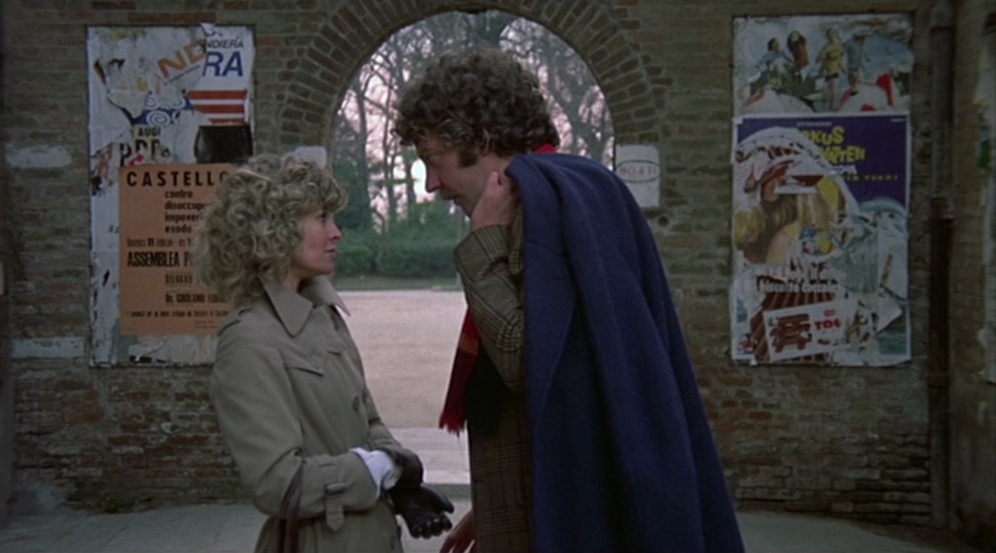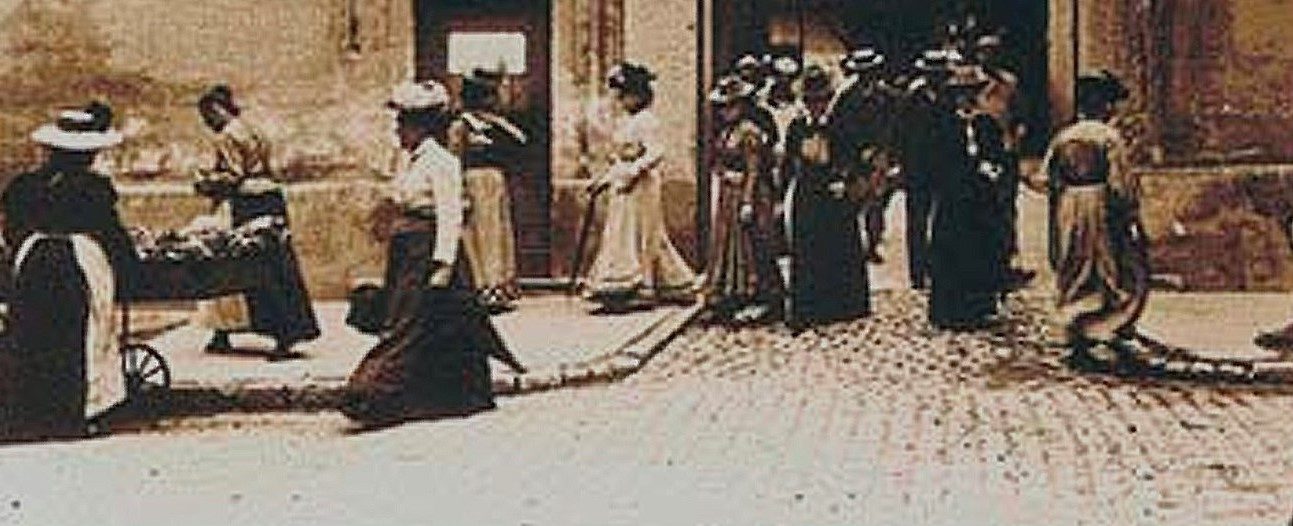United Kingdom, Italy, 1973
Directed by Nicolas Roeg
With Donald Sutherland (John Baxter), Julie Christie (Laura Baxter), Hilary Mason (Heather), Clelia Matana (Wendy), Massimo Serato (Bishop Barbarrigo)

The film’s prologue relies on a virtuoso use of cross cutting editing. It starts quietly as the camera follows a little happy girl walking in the woods surrounding a countryside mansion. Her red plastic mac gives her the looks of the Little Red Riding Hood cavorting on a pleasant autumn day. There is, however, an odd detail: she is playing not with a doll but with a fake soldier giving orders about mortars and assault, a rather brutal game for a girl. A little boy is coming on his bike while in a big room in the house a woman is browsing books and a man works on slides. The moves of every characters are quickly mixed and the editing becomes increasingly frenzied and disturbing until the tragic climax is reached: the powerless father bringing home the body of his daughter who drowned in the pond under her brother’s gaze.
This factual development is accompanied by a stunning visual effect, a stain caused by the spilling of some beverage turning into a huge splash of red on the surface of a slide representing the inside of a church, one of the slides the father had already handled earlier in the montage. The trick boldly highlights the tragedy but also gives a truly creepy edge to the story, already suggested by the bizarre attitude of the father who at one point seems to guess her daughter’s death even if he is yards away.
This feat of montage not only bluntly gives the starting point of the plot that would involve the lead adult characters; it also cleverly exposes the film’s atmosphere, the distressing visual symbolism this plot is going to exploit, namely that pervasive, attention-catching and somehow menacing red color as well as the fragmentation of simple facts and deep feelings through the montage of brief and intense shots; so are highlighted the underlying and unnerving themes of the narrative, the reality, at least for the characters, of psychic powers and the overriding influence of fate.
After the accidental death of their daughter Christine, John Baxter and his wife Laura leave their English home to travel to Venice (their son Johnny is sent to a boarding school). If Laura felt she needed the break, it is a business trip for John whose skills are needed to restore an old church managed by a bishop, Barbarrigo. The sojourn takes an unexpected turn when Laura has by chance a chat with two other Britons walking around Venice, Heather and Wendy. They are middle-aged and quiet sisters but it turns out that Heather is a clairvoyant – and that she speaks with Christine.
This astonishing claim brings strangely some comfort to Laura but makes John fly off the handle. It thus alters their attitudes which now stand at the opposite of what they used to be during the previous weeks: Laura becomes more confident while John grows increasingly insecure. Things get worse after Laura had to leave briefly the place to look after Johnny who had a (minor) accident back in England. John is sure she is actually still around as he notices her boarding a ship with the two sisters. He compels the police to investigate the two women, basically because they have always annoyed him but also because he fears for his dear wife’s life as a serial killer is committing grisly murders in the town. A phone call by Laura proves him he was wrong and he gets the ladies released. But he would meet another Little Red Riding Hood in the streets and once again death would strike.
The new, long-winded, tragedy occurring to the Baxters takes place in a well-known place that is out of the blue harder to recognize and to enjoy. Celebrated vistas are overlooked to the benefit of more dilapidated and dirty corners; the leads end up walking aimlessly in back streets under a light as cold as it was back in the English-set prologue and perhaps with an even harsher nuance. By the way this is not Venice at the best time of the year: this is wintertime, and their hotel closes for the season. People, starting with the hotel manager, are not really friendly, in a sharp departure from the hackneyed images on the touristic place. And of course the town’ tranquility is upset by that shocking killing spree.
This is a daunting environment and it perfectly suits the thrust of the story. Incidents and symbolism easily fuel a deepening sense of foreboding, which is the point of the story (an adaptation of a fiction written by Daphne du Maurier). Should psychic powers be taken seriously? For John they can’t; and in one case of intercut shots, the film first suggests he is right as a dispute between the Baxters is cut by a shot on the two sisters splitting sides (are they laughing at Laura?). But an accident in his workplace, dramatically shot, with an exaggeration worthy of a Hollywood cliffhanger, casts a doubt. The final section of the film, which poignantly mirrors the prologue as it graphically depicts a horrible death, gives the story its full meaning: the dizzying cross cutting montage of surprising shots pick up many pieces showed earlier to make them fit into a wider image suggesting that after all there is some reality to the clairvoyants’ hyped gift. There is some bitter irony in this end as it makes clear John had that gift but was unable to understand it – and all the while the director has deftly exploit this distressing enigma of the human fate to create an increasingly relentless and riveting tension.
“Don’t Look Now” owes part of its celebrity to a steamy sex scene whose frankness stunned. But the nudie shots are part of another remarkable parallel editing, alternating with the sober and mundane attitudes of John and Laura Baxter after their lovemaking as they get ready to dine out. Carnal desire is blended with day-to-day life: sex then feels like a perfectly natural act between lovers, an assertion the film makes on its own, sophisticated, terms and highlighting how ordinary the couple is and, by contrast, how extraordinary and harsh the events befallen them are. Some of those nudie shots feature in the final flourish of parallel montage, and rightly so: it is a stark reminder of a past life that was not quite on the verge of unraveling but that fate has made impossible to pursue, leading to the heartbreaking images of mourning over which the end credits roll.

